Posts Tagged ‘illegal logging’
Tuesday, February 21st, 2012
This article was initially published on 20110728 by the UK based Environmental Investigation Agency (EIA) under its press release entitled ‘Vietnamese Army named as timber smuggler’, Contact: EIA, 62-63 Upper Street, London N1 0NY, United Kingdom, ^www.eia-international.org]
.
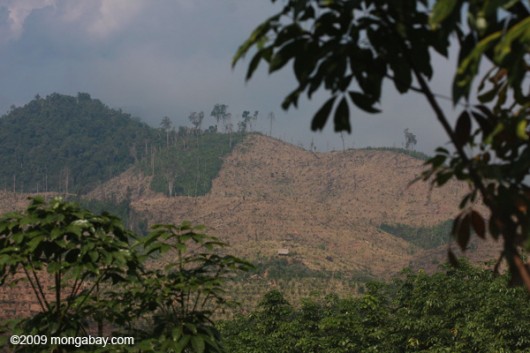 Forests in Laos have declined steadily in recent decades,
falling from 64% cover in 1960 to 41% in 2005.
Primary forests now cover less than 10 % of the country according to U.N. data.
(Source: Mongabay, ^http://news.mongabay.com/2011/0622-laos_crackdown.html) Forests in Laos have declined steadily in recent decades,
falling from 64% cover in 1960 to 41% in 2005.
Primary forests now cover less than 10 % of the country according to U.N. data.
(Source: Mongabay, ^http://news.mongabay.com/2011/0622-laos_crackdown.html)
.
BANGKOK: A new report released today (20110728) exposes the pivotal role played by the Vietnamese military in a multi-million dollar operation which is smuggling threatened timber over the border from the shrinking forests of neighbouring Laos.
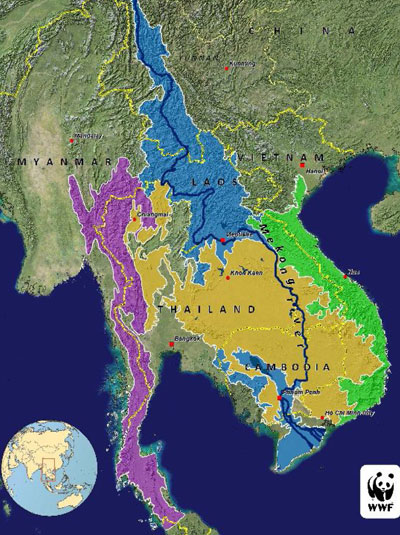 Greater Mekong Region Greater Mekong Region
.
Laos has some of the Mekong region’s last intact tropical forests, but the London-based Environmental Investigation Agency (EIA) report Crossroads: The Illicit Timber Trade Between Laos and Vietnam reveals its export ban on raw timber is routinely flouted on a massive scale to feed the ravenous timber processing industries of Vietnam, China and Thailand.
During undercover operations in 2010 and 2011, EIA agents posing as timber buyers tracked a trail of corruption and inadequate enforcement back from the busy furniture factories and ports of Vietnam to its border with Laos and beyond.
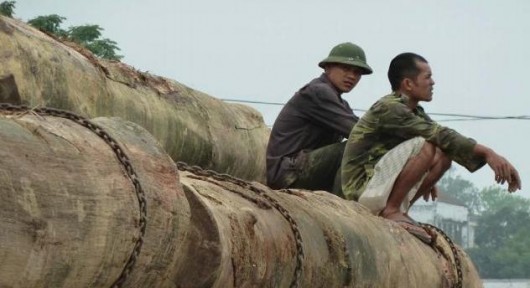 The forests of Laos support the livelihoods of millions of rural and indigenous people but are seriously threatened by over-exploitation; such is the volume of illegal timber flowing through Laos’ porous borders that its furniture manufacturing industry is finding it cannot supply orders due to a lack of raw materials. The forests of Laos support the livelihoods of millions of rural and indigenous people but are seriously threatened by over-exploitation; such is the volume of illegal timber flowing through Laos’ porous borders that its furniture manufacturing industry is finding it cannot supply orders due to a lack of raw materials.
Through investment in logging, plantations and hydropower projects, Vietnamese firms have appropriated large swathes of Lao forests, yet the only winners in Laos are corrupt Government officials and well-connected businessmen. Meanwhile, Vietnamese logging companies and furniture factories are booming on the back of the illegal trade, exporting billions of dollars worth of finished wood products to the major markets of the USA and European Union.
And EIA’s investigations revealed that one of the biggest loggers in Laos is a company owned by the Vietnamese military. Investigators first encountered the Vietnamese Company of Economic Cooperation (COECCO) in October 2010 during a visit to Qui Nhon port, documenting huge piles of logs bearing green paint marks and tagged with yellow labels bearing a Vietnamese name which translated into Company of Economic Cooperation – Ministry of Defence (or COECCO). A port worker said 95 per cent of the logs had come from
Laos and most were owned by the Vietnamese military; specifically Military Zone 4.
Similarly marked logs were observed in a huge storage area between the two formal checkpoints at the Bo Y border crossing (‘F‘ on map below) and EIA was eventually able to confirm that most of them had come from logging operations linked to the construction of a nearby hydropower dam.
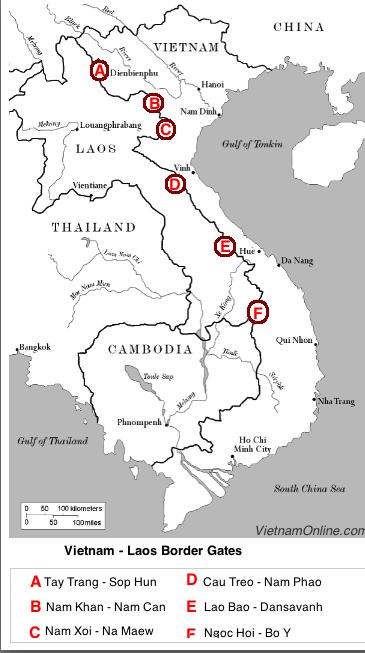
To uncover more details of the company’s operations, EIA investigators travelled to COECCO’s headquarters in Vinh City, Vietnam, in May 2011 and learnt COECCO has been in the timber trade and logging business in Laos for more than 20 years, that it sources most of its logs from Lao dam clearance sites and that it is one of a handful of companies permitted to carry out logging in these areas.
A well-connected Lao company is also making a fortune trading logs to Vietnam; the Phonesack Group, the boss of which is connected with the Lao Government, prefers to send logs across the border while its own wood processing struggles to get supplies of raw material.
EIA Head of Forest Campaign Faith Doherty said:
“EIA first exposed the illicit log trade between Laos and Vietnam in 2008, and our latest investigations reveal that sadly nothing has changed.
“The governments of Vietnam and Laos urgently need to work together to stem the flow of logs and curb the over-exploitation of Laos’ precious forests before it’s too late, and the Vietnamese military must be excluded from logging operations in Laos. “With a new Timber Regulation coming into force within European markets in 2013, both Vietnam and Laos have a lot at stake and urgently need to work with the European Union.”
.
Urgent Call to Action – by EIA
.
1. THE GOVERNMENT OF LAOS SHOULD:
- Enforce its log export ban
- Publish details of all logging quotas and the selection process
- Clarify rules for converting forest land for plantations
.
2. THE GOVERNMENT OF VIETNAM SHOULD:
- Respect the policies of the Lao Government by blocking log imports from the country
- Hold bilateral talks with the Government of Laos over illicit wood trade between the two countries
- Work with Vietnamese wood industry associations to exclude Lao logs from its supply chain
- Exclude military businesses from carrying out logging operations in Laos
.
3. THE EUROPEAN UNION SHOULD:
- Ensure that any Voluntary Partnership Agreement (VPA) discussions with Vietnam and Laos address the issue of log trade between the two countries
- Ensure that VPA talks include the full range of stakeholders
- Promote forest governance lessons from FLEGT (Forest Law Enforcement, Governance and Trade) into the development of REDD+ (Reducing Emissions from Deforestation and Forest Degradation) , specifically in terms of displaced deforestation
.
4. COMPANIES AND CONSUMERS SHOULD:
- Obtain proof that wood products sourced from Vietnam are not derived from logs imported from Laos
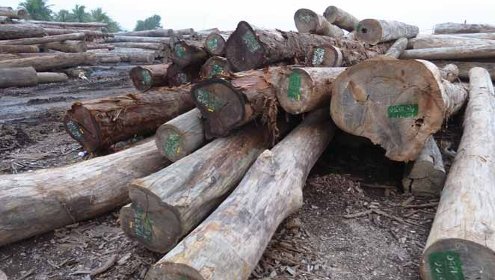
Copies of the full Crossroads report, stills and footage are available on request from Environmental Investigation Agency (EIA) Press Officer Paul Newman at paulnewman@eia-international.org, or or Faith Doherty at faithdoherty@eia-international.org.
.
Illegal logging and the associated trade in stolen timber
.
[Source: ‘Transnational Organised Crime in South East Asia: Threat Assessment‘, article in newsletter ‘NTS Alert’, July 2010 (Issue 1), published by the Centre for Non-traditional Security Studies (NTS), within the S. Rajaratnam School of International Studies (RSIS), Graduate School of Nanyang Technological University, Singapore, ^http://www.rsis.edu.sg/nts/HTML-Newsletter/alert/NTS-alert-jul-1001.html]
.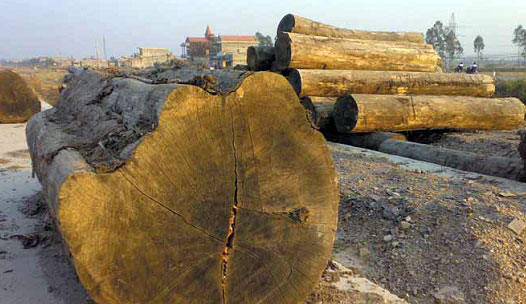 Yellow balau log from Lao Peoples Democratic Republic, awaiting transportation. Yellow balau log from Lao Peoples Democratic Republic, awaiting transportation.
(Photo : Environmental Investigation Agency, 2008)
.
Illegal logging occurs when timber is harvested, transported, processed, bought, or sold in violation or circumvention of national or sub-national laws (Miller et al., 2006). Between 8 and 10 per cent of global wood products stems from illegal logging, with annual global market value of losses estimated at over USD 10 billion (United Nations Office on Drugs and Crime – UNODC, June 2010). Southeast Asia is a major supplier of illicit timber with an estimated annual turnover of USD 3.5 billion. As much as 40 per cent of wood-based products imported into the EU in 2008 and half of China’s imports in 2007 (worth USD 900 million) originated from illegal logging.
Indonesia remains the country most heavily affected by illegal logging. The country possesses 123 million ha of forest (10 per cent of global forest cover) including the third largest tropical rainforest. As much as 80 per cent of timber logged in Indonesia is suspected to be illegally sourced with annual losses in government revenue estimated at USD 2 billion (Human Rights Watch, 2009). The Indonesian Ministry of Forestry estimates that in recent years, the country lost between 1.6 and 2.8 million ha of forest annually (between 3 and 5 ha a minute) to illegal logging and land conversion (UNODC, June 2010).
.
Imported Rainforest Timbers to Australia
[Source: ‘The Good Wood Guide: A Residents Guide to Purchasing Environmentally Friendly Timber’, Waverley Council, NSW, ^http://www.wettropics.gov.au/st/rainforest_explorer/Resources/Documents/8to9/GoodWoodGuide.pdf]
.
About 13% of Australia’s sawn timber is sourced from tropical forests. We also import tropical rainforest timber items such as veneers, plywoods and picture mouldings. The majority of these timber products are sourced from unsustainably logged forests and could be replaced by sustainable locally grown alternatives.
Logging tropical rainforests causes the extinction of hundreds of plant and animal species each year in addition to loss of the home of many indigenous tribal peoples. In South East Asian rainforests the rate of clearing is five million hectares per year. Once an intact rainforest has been destroyed, it cannot be replaced for thousands of years.
Ed: A rainforest is not a ‘renewable resource’. Rainforest timber is driving extinctions.
.
Commonly Imported South East Asian Rainforest Timbers to Avoid
.
- Meranti
- Merbau
- Ramin
- Pacific Maple
- Philippine Mahogany (Calantas)
- Keruing (also known as Naytoh, Narra and Kapur)
- Teak
- Jelutong
- Motoa (also known as Merawan, Batu)
- Balau
.
Old-Growth Forests
.
‘Old-growth forests are native forests which have had no recent disturbance by humans and regenerate naturally over hundreds of years. Like rainforest, old growth forests provide vital habitats for many species of flora and fauna. These forests are becoming increasingly rare both overseas and in Australia. Consequently we recommend that you avoid timbers sourced from old growth forests.’
Chea Sa Timber wholesales SE Asian rainforest timbers

…’We are a well established trading company situated in Malaysia. We have been in this industry since year 1995 and have earned superb reputation in our business circle. We offer a large variety of Tropical sawn timber. We have excellent sources and reliable network to fulfill both local and international market. ‘Currently, our overseas customers including Singapore, Hong Kong, China, Japan & etc. We intend to further expand our business to new markets abroad and looking for long term business partners worldwide.
Products
We specialize in following sawn timber, size in accordance to customer’s requirement:
- Finger Jointed Wood (Meranti, Durian, Sesendok)
- Meranti (Light Red/Dark Red)
- Kapur
- Kempas
- Keruing
- Merbau
- Merbatu
- KSK (Kembang Semangkok, or ‘Samrong’)
- Yellow Balau (Selangan Batu) & etc
.
[Source: ^http://www.cheasatimber.com/index.html]
.
‘Serano Timber’ in Dandenong Victoria retails Yellow Belau’
.

 Source: ^http://www.seranotimber.com.au/yellow-balau.html
Source: ^http://www.seranotimber.com.au/yellow-balau.html
.
Further Reading:
.
[1] FLEGT (Forest Law Enforcement, Governance and Trade), ^ http://www.euflegt.efi.int/portal/ ‘The Forest Law Enforcement, Governance and Trade (FLEGT) Action Plan sets out a range of measures available to the European Union and its Member States to tackle illegal logging in the world’s forests. Use the menu on the left to find more information about the FLEGT programme.’
.
[2] UN-REDD (Reducing Emissions from Deforestation and Forest Degradation), ^ http://www.un-redd.org/ ‘ The UN-REDD Programme is the United Nations Collaborative initiative on Reducing Emissions from Deforestation and forest Degradation (REDD) in developing countries. The Programme was launched in September 2008 to assist developing countries prepare and implement national REDD+ strategies, and builds on the convening power and expertise of the Food and Agriculture Organization of the United Nations (FAO), the United Nations Development Programme (UNDP) and the United Nations Environment Programme (UNEP).’
.
[3] Illegal Logging (UK-based) website, ^ http://www.illegal-logging.info/index.php , ‘ The purpose of this site is to provide information on the key issues in the debate around illegal logging and the trade in illegal timber, via news stories and key documents, as well as details of relevant events, and links to other relevant websites.’
.
Tags: Balau, Bo Y border crossing, Greater Mekong Region, illegal logging, Illicit Timber Trade, Lao Government, Laos, Phonesack Group, rainforest timber, Vietnamese Army, Vietnamese Company of Economic Cooperation, Voluntary Partnership Agreement
Posted in Mekong (VN), Threats from Deforestation | No Comments »
Add this post to Del.icio.us - Digg
Wednesday, November 23rd, 2011
‘The axe had never sounded’…
.
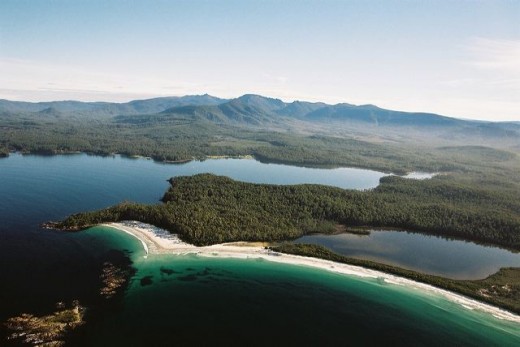 Unprotected ancient native forests around Tasmania’s Recherche Bay Unprotected ancient native forests around Tasmania’s Recherche Bay
(Photo by Bob Brown)
.
Despite Tasmania’s Inter-governmental Agreement (IGA) on 7th August 2011 assuring immediate logging moratorium of native forests in agreed reserves, Forestry Tasmania continues to eco-rape and pillage protected native forests in defiance of this agreement.
IGA Clause 25 states:
‘The State will immediately place the 430,000 hectares of native forest identified in Attachment A (other than any areas that are not State forest), from the 572,000 hectares nominated by ENGOs through the Statement of Principles process, into Informal Reserves. The boundaries of this 430,000 hectares were verified through an independent verification process.’
The southern forests around Recherche Bay were agreed to be included into the Informal Reserves through the Independent Verification Process.
So by embarking on new logging in these Informal Reserves, clearly Forestry Tasmania is in breach of the IGA and operating out of the control of the Tasmanian Government. Forestry Tasmania is logging Tasmania like there’s no tomorrow, because it knows there it has no tomorrow. The business is seriously loss-making. It’s continuing unfettered destruction of Tasmanian native forests is akin to the calculated genocide of Sri Lankan Tamils in May 2009 by the Sinhalese Sri Lankan dictator Mahinda Rajapaksa. Forestry Tasmania’s manic mindset has it logging and woodchipping native forests until they’re all decimated. And Lala’s Labor Government doesn’t have the gumption to enforce the moratorium on its own renegade department.
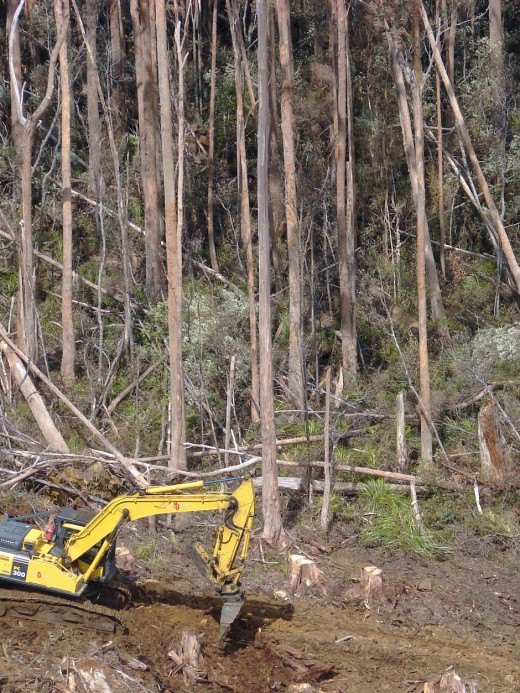 Forestry Tasmania getting stuck into native forests near Tasmania’s Recherche Bay, May 2011
[Source: ABC, ‘Bid for forest peace funding’, 20110519, ^http://www.abc.net.au/news/stories/2011/05/18/3220585.htm?site=hobart] Forestry Tasmania getting stuck into native forests near Tasmania’s Recherche Bay, May 2011
[Source: ABC, ‘Bid for forest peace funding’, 20110519, ^http://www.abc.net.au/news/stories/2011/05/18/3220585.htm?site=hobart]
.
Not only is this organisation out of control, it has no market for its woodchip product. The logs are trucked to woodchipping mills only to be stockpiled with nowhere to go. With no income, it is a business heading for collapse. Unpaid wages will likely remain that way, when the doors are finally closed up. Meanwhile Tasmania’s remaining old growth forests are being logged and the ancient vital ecology decimated.
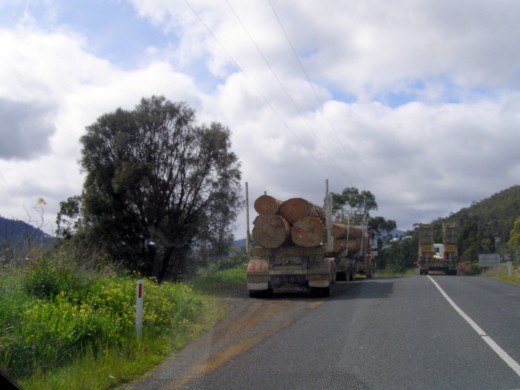 Loaded logging truck (New Norfolk, 20110929)
(Photo by editor, free in public domain) Loaded logging truck (New Norfolk, 20110929)
(Photo by editor, free in public domain)
.
Conservationists are this morning conducting a protest in a logging area in the far south of Tasmania, where world heritage value forests are being clearfelled.
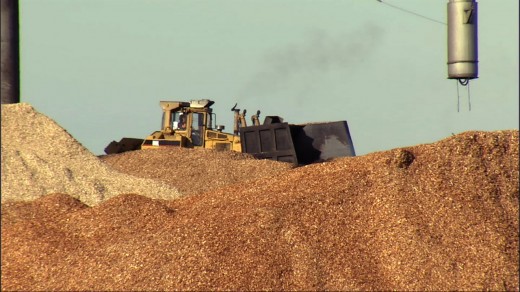
.
Huon Valley Environment Centre’s Jenny Weber says:
‘Tasmania’s world heritage value forests continue to be logged despite yesterday’s controversial announcement that woodchips shipments have been postponed by Tasmania’s only export woodchipping company, Artec (Artec Pty Ltd, Lilydale).’
‘Ta Ann is driving logging in contentious forests, and woodchip logs are leaving these same forests regardless of a viable market for the timber. The Tasmanian taxpayers are subsidising a logging industry that is economically unviable and environmentally unsustainable.’
‘This morning at Catamaran, in threatened forest behind Recherche Bay, a conservationist is in a tree sit, and thirteen people are halting logging. Huon Valley Environment Centre is repeating it’s calls for the immediate end to logging in this forest that borders the Tasmanian Wilderness World Heritage Area, (TWWHA).’
.
Logging in this area, identified by Forestry Tasmania as CM004C, commenced after the Prime Minister Julia Gillard and Premier Lara Giddings announced the Inter-governmental Agreement on 7th August 2011 would provide ‘immediate protection in informal reserves’ for forests such as these.
 Tasmanian Premier Lara Giddings and Australian Prime Minister Julia Gillard
signing the Tasmanian Forests Agreement, 7th August 2011 Tasmanian Premier Lara Giddings and Australian Prime Minister Julia Gillard
signing the Tasmanian Forests Agreement, 7th August 2011
.
Forestry Tasmania Coupe ‘CM004C’ is located within the 572 000ha of identified forests for legislated protection. Last week conservationists participated in a protest in the coupe, and it was revealed that the area is being clearfelled for Ta Ann, export peeler logs and woodchip logs.
 Forestry Tasmania’s cable logging of The Weld Forest, 2009
Tasmanian Southern Forests
(Huon Valley Environment Centre)
(click image to link to slide show) Forestry Tasmania’s cable logging of The Weld Forest, 2009
Tasmanian Southern Forests
(Huon Valley Environment Centre)
(click image to link to slide show)
IGA Clause 26 states:
.
‘The State will ensure that, until the further independent verification process required under Clause 20 is completed, wood supply required under Clause 17 will be sourced from outside the 572,000 hectares of ENGO-nominated High Conservation
Value forest area unless the remaining State Forest area is insufficient to meet the contractually specified quality and quantity of wood supply. Where this is the case, the Tasmanian Government will ensure that wood supplies are sourced outside the 430,000 hectares placed in Informal Reserves. The Tasmanian Government will ensure that the 430,000 hectares of State Forest identified in Attachment A is not accessed’
.
Analysis:
-
There are copious hundreds of hectares of Tasmanian forest area available outside the 572, 000 hectares of ENGO-nominated High Conservation Value forest area.
-
The Lala Labor Government by not ensuring wood supply is sourced outside the 430,000 ha in Informal Reserves is not accessed, and thus in prima facie breach of the IGA. Lala Labor is deliberately and mischievously exercising selective deafness by not listening to ENGO accusations of the breach of the IGA terms. Labor as head wolf of the chicken pen, turning a blind eye to its fellow wolves while they help themselves to the plunder.
-
The Gillard Labor Government is in breach of IGA Clause 27, by failing to act on this trigger ‘to appoint independent expert specifically to review scheduling and other relevant data and attempt to reschedule harvesting activities so as to meet the requirements of contracts and maintain the interim protection of the 430,000 hectares’. The option of log anyway is not an option. The prescribed option under IGA Clause 27, is that the Commonwealth will instead compensate the contract holder for the value of lost profits and unavoidable costs.
-
Both Governments, by sitting on their hands as forests in the Informal Reserves are logged, are in breach of the spirit of the Agreement.
.
.
2009: ‘Woodchip stockpile in Tasmania a ‘health risk’
[Source: Matthew Denholm, Tasmania correspondent, The Australian, 20091014, ^http://www.theaustralian.com.au/news/woodchip-stockpile-in-tasmania-a-health-risk/story-e6frg6ox-1225786465432]
.
The woodchip stockpile in Burnie could pose a “significant health risk”, according to an expert opinion being assessed by health authorities. Tasmanian Director of Public Health Roscoe Taylor said the advice that the stockpile would at times contain Legionella bacteria is being examined.
“I have actually asked someone to have a look at it — we’ll be taking a look at it,” Dr Taylor said.The advice from Legionella expert Trevor Steele concludes the bottom layer of the stockpile on Burnie’s wharf would “undoubtedly” contain Legionella at times. Dr Steele warned the bacteria’s dispersal via dust could pose a significant health risk to townsfolk near the wharf and to workers at the port.
“It (the bottom layer) will at times undoubtedly contain Legionella and these could multiply there given the right conditions,” he said.
“This layer would also act as a source to contaminate newly arrived woodchips, setting the stage for a new cycle of Legionella growth.
“Dispersal of dust … containing these organisms could pose a significant health risk to susceptible persons working in, or residing in, adjacent residential or business districts, as well as to susceptible workers on the Gunns site and in the port area.”
Dr Steele was commissioned to provide the advice by Royal Hobart Hospital physician Frank Nicklason. Last week, Dr Nicklason apologised to timber company Gunns for his 2004 statement that the woodchip pile “almost certainly” had Legionella present that could blow across Burnie. However, he said his concerns about the potential for public health risks from the pile — initially sparked by several Legionella cases in Burnie — remained.
Dr Nicklason said he accepted that Gunns’ sampling in 2002 had not found Legionella in the pile. However, he said Dr Steele’s findings, from July this year, contributed to his concern and warranted further investigation.
Gunns’ own advice, conducted independently in 2002 and released under Freedom of Information, found that the available evidence “suggests strongly” that the bottom layer is “not a reservoir for Legionella”.
However, Dr Steele, formerly director of clinical microbiology at the Institute of Medical and Veterinary Science in Adelaide, disagreed.
“To claim that the sacrificial layer did not contain Legionella on the basis of two tests of small samples is misleading,” he says.
He agreed the bottom layer, because it was relatively undisturbed, was unlikely to pose much risk to the community, but that this did not mean there was no risk, since Legionella there could contaminate new woodchips.
When asked whether Gunns stood by its own findings, a spokesman said: “We don’t have to: Dr Nicklason has stood by it.
“At the time Dr Nicklason gave this apology he was in possession of the Steele report. His attempt to retract his apology by reference to this report is hypocritical, disingenuous and beggars belief.”
Dr Nicklason said his “carefully worded” apology — made as part of settlement of defamation proceedings — merely acknowledged that Legionella had not been found in samples taken by Gunns, and that its report had concluded there was “no available data” to implicate woodchips as a microbial health risk.
There are few detailed studies of Legionella in woodchip piles, although Dr Steele has found the bacteria present in all forms of composting and degrading wood products, including woodchips.
On the basis of his work, Dr Steele believes that conditions in woodchip stockpiles are ideal for Legionella and other micro-organisms that require moisture and warmth.
Legionella is thought to spread by people inhaling the bacteria contained in tiny water droplets, known as aerosols, or in dust.
Over the years, there have been complaints about dust and debris blowing from the stockpile to the Burnie CBD, adjacent to the port.
These have been focused on days of easterly winds, which occur about 20per cent of the time, and when woodchips were being loaded on to ships.
The 2002 Gunns report, conducted by Adelaide environmental health expert Richard Bentham, pointed out that survival of Legionella in aerosols was “highly dependent upon ambient weather conditions”.
For this reason, Dr Bentham concluded the health risks from the Burnie pile were “most probably confined to employees or contractors working on the site” and that transmission beyond the port area was “unlikely”.
However, Dr Steele says Legionella “could survive well in dust travelling long distances, even in adverse climatic conditions”. He cites instances of up to 20km.
.
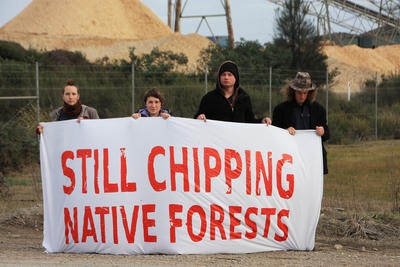
.
.
Recherche Bay – a brief background
.French explorer D’Entrecasteaux led his ships to grateful shelter in Recherche Bay, southwest of Hobart, in 1792 and 1793, recording “ancient forests, in which the sound of an axe had never been heard”. Barely 200 years later, the forest of Recherche Bay is being threatened by the sound, not merely of axes, but of bulldozers and chainsaws.In spite of public protest and National Heritage listing, the green light to log the area has been given.
- 24/1/06 Entrepreneur/adventurer Dick Smith offers $100,000 towards the purchase of Recherche Bay plus a $1.9 million no-interest loan to be paid back within 12 months.
- 5/11/05 Over 5000 people rally in Hobart for the protection of Recherche Bay. Bob Brown launches a bid to purchase the peninsula, asking people to pledge units of $1,000 to raise the money. Bob pledges $5,000.
- 6/10/05 Senator Ian Campbell announces Recherche Bay will be placed on the National Heritage list but says logging will still go ahead.
- 19/8/05 Launch of Bob Brown’s photographic exhibition and book, Tasmania’s Recherche Bay
- 27/4/05 Actor David Wenham and director Robert Connolly fly over Recherche Bay and visit the tall trees in the Styx Valley, stating their support for conservation.
- 20/4/05 Tasmanian Greens leader Peg Putt calls on French scientists to help save Recherche Bay
- 17/4/05 1000 people rally on site to protect Recherche Bay
- Nov, 03 Tasmanian Heritage Council recommends the protection of the north east peninsula for its cultural significance.
[Source: ^http://www.leatherwoodonline.com/wild/2006/recherche_bay/index.htm]
.
.
1993: ‘Campaign over Recherche Bay scores win’
[Source: Bob Elliston, Hobart, Green Left Weekly, 19931117, ^http://www.greenleft.org.au/node/34677]A five-year campaign to save part of historic Recherche Bay, in south-east Tasmania, has been won, with all parties involved having achieved a satisfactory resolution. The agreement was announced on February 8 by Labor Premier Paul Lennon.Thanks mostly to the support of well-known philanthropist Dick Smith, the tireless negotiations of Greens Senator Bob Brown and the decency of owners David and Robert Vernon, 142 hectares of forest will now be purchased by the Tasmanian Land Conservancy for $2.21 million.Recherche Bay had been under the threat of logging by Gunns Ltd since a contract with the owners was signed in 1998. The bay became home to a French expedition to observe the Earth’s magnetic field in 1792 and 1793. Had logging gone ahead, today’s very destructive logging techniques would have destroyed any chance for useful archaeology of the site to be conducted.Under the deal, Dick Smith will lend the Conservancy group $2 million, $100,000 of which is a personal donation. The state government, which initially supported the Vernon brothers’ decision to have the area logged, has now agreed to assist with $210,000 towards the cost of the land. In addition, the government will waive the $80,000 it would have collected in stamp duty. donations exceeding $238,000 have already been pledged.Although the small forest will not be harvested, no jobs will be lost. More jobs are likely to be generated in services supporting the local community and scientific interest.
However, the deal is not without its critics. Terry Edwards, CEO of the Forestry Industries Association, is distressed that the forest will continue to grow, rather than be turned into cash for Gunns. Newly appointed federal forests minister and Tasmanian senator Eric Abetz has also criticised the agreement, describing it as “a grubby deal”. According to Abetz, the area “has no heritage value”.
.
.
Further Reading:
.
[1] The Last Stand, ^http://www.thelaststand.org.au/, Media Release 20111116:
‘The HVEC and Code Green have taken direct action on Tassie’s forest floor this morning to highlight ongoing logging in high conservation value forests that were supposed to be protected under the Inter-governmental Agreement. Campaigners are currently taking simultaneous action in two logging coupes in the north and south of the island – RS117C on Roses Tier, north of Ben Lomond, and in the Catamaran area, where forests are being logged behind Recherche Bay.
“This is an area that should have been given immediate protection on March 15 this year. Instead we are still seeing machines clearing what has been identified by both the State and Federal Governments as being of high conservation value.” Said Jared Irwin, spokesperson for Code Green.
“The lost values of these forests that are bordering the Tasmanian Wilderness World Heritage Area is such a tragedy, when the logging commenced after the State and Federal Governments announced they would be protected in August 2011,” Said Jenny Weber, Huon Valley Environment Centre’s spokesperson.’
.
[2] ^http://www.nativeforest.net/
.
[3] Tasmanian Intergovernmental Forest Agreement 2011, ^http://australia.gov.au/content/tasmanian-forests-agreement
.
[4] ‘The Axe Had Never Sounded: place, people and heritage of Recherche Bay, Tasmania’, by John Mulvaney, published by ANU E Press and Aboriginal History Incorporated, ANU E Press,
^http://epress.anu.edu.au/aborig_history/axe/html/ch13.html
.
‘A thriving sawmilling industry existed at two centres around the bay by 1900. The steam-driven mill continued at Waterhole Cove until 1868. Then the industry faltered until 1884, when large sawmills were established by the Catamaran River and at Leprena on the western side of the northern bay. By 1900 the population living there exceeded 100 at each centre. It was around the turn of the century that coal mining also offered employment, and an active industrial period followed for a few years. The seams of coal proved limited or uneconomic. As trees were felled, their distance from the sawmill increased. This required timber rail tramways establishing a network radiating out from an area and moved on when that area was harvested. The same applied to transporting coal.
By 1939 a complex network radiated from harbour-based centres at Catamaran, Leprena and Cockle Creek. Traces of these lines survive today in regrowth forests.[1] One moss-covered segment runs by the shore on the north-eastern peninsula in the area of the French activities in 1792.
The timber industry is necessarily situated in forests, so bushfires prove a recurring hazard. The Catamaran mill was destroyed in a 1914 bushfire, coinciding with the abandonment of the coal mine there. The spasmodic and transitory nature of frontier employment was again demonstrated at Recherche Bay when the community of around 100 people, supporting a school and a store, faced sudden unemployment. Today the media feature factory closures and speculate about the future employment of the urban employees. The history of much of rural Australia also has been a boom and bust story of employment, as rural industries prosper then fold. Recherche Bay is a classic example. On a smaller scale than urban plant closures, the impact upon the families dependant upon a timber mill or colliery was no less drastic.’
[Chapter 13. Good and Bad Times]
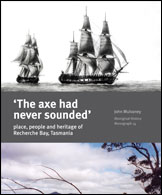
|
The State will ensure that, until the further independent verification process required under Clause 20 is completed, wood supply required under Clause 17 will be sourced from outside the 572,000 hectares of ENGO-nominated High Conservation Value forest area unless the remaining State Forest area is insufficient to meet the contractually specified quality and quantity of wood supply. Where this is the case, the Tasmanian Government will ensure that wood supplies are sourced outside the 430,000 hectares placed in Informal Reserves. The Tasmanian Government will ensure that the 430,000 hectares of State Forest identified in Attachment A is not accessed. Where harvesting work has already begun in coupes within the nominated 430,000 hectares, rescheduling will occur as soon as practical and a list of coupes that will be harvested will be agreed by the Governments and the signatories, advised by the Independent Verification Group, within two weeks of the signing of this agreement. If sourcing of wood supply from within the 572,000 hectares is considered to be necessary under any circumstances, the Governments will immediately consult with the Reference Group of Signatories and the Independent Verification Group in order to inform them of the basis for sourcing wood supply in those areas, and with the intention of providing this supply in a way that minimises impacts on conservation values.
|
|
During the independent verification process, in the event that Forestry Tasmania reports that it cannot meet contractual requirements from production resources outside the nominated 430,000 hectares, the Governments will undertake the following steps. First, an independent expert will be jointly appointed by the Governments to review scheduling and other relevant data and attempt to reschedule harvesting activities so as to meet the requirements of contracts and maintain the interim protection of the 430,000 hectares. In the event that the independent expert concludes that it is impossible to achieve this through rescheduling on a reasonable commercial basis or through sourcing alternative supplies, the Commonwealth will compensate the contract holder for the value of lost profits and unavoidable costs. Any such costs will be met, in the first instance, from within the $7 million payment in financial year 2011-12 referred to in Clause 35.
|
Tags: Catamaran, Clause 25, Forestry Tasmania, IGA, illegal logging, logging moratorium, Recherche Bay, Roses Tier, Ta Ann Group, Tasmanian Forests Intergovernmental Agreement, Tasmanian Wilderness World Heritage Area, the axe had never sounded, Weld Forest, woodchip horders, woodchip stockpile health risk
Posted in Tasmania (AU), Threats from Deforestation, Threats to Wild Tasmania | No Comments »
Add this post to Del.icio.us - Digg
Friday, August 19th, 2011
(The following article was initially posted on CanDoBetter.net by Tigerquoll on 20090426. It has since been modified.)
.
 VicForests’ neo-colonial practice of logging old growth East Gippsland forests, justifies such culling by claiming compliance with Australia’s wood production Standard AS 4708-2007. But this standard is Mein Kampf for ecological genocide of East Gippsland Forests. VicForests’ neo-colonial practice of logging old growth East Gippsland forests, justifies such culling by claiming compliance with Australia’s wood production Standard AS 4708-2007. But this standard is Mein Kampf for ecological genocide of East Gippsland Forests.
Have a read: http://www.forestrystandard.org.au/files/Standards/4708.pdf [Read the Standard]
Under this official Australian Standard that sees only the wood for the trees, it includes two criteria that serve to deliver propaganda spin respect for forest ecology. One must recognise these criteria accompanying Criterion 4—Forest management shall maintain the productive capacity of forests. Need I say more?
Forestry Propaganda Criterion #3 for instance, requires forest management to ‘protect and maintain the biological diversity of forests’. Wonderful wholesome, noble and holistic rumblings about this one – but gullibles wake! VicForests <em>Mein Kampf</em> hides the ‘ chainsaw-speak‘ in the detail:
* ‘Small-scale clearing is permitted up to a limit of 40 hectares on a single forest management unit’. ‘Conservation of threatened (including vulnerable, rare or endangered) species and ecological communities requires the forest manager to minimise adverse impacts by ensuring he/she takes into account of known information and relevant specialist advice‘. (Makes Fiji look like a democracy!)
Forestry Propaganda Criterion 5 requires forest management to maintain forest ecosystem health and vitality, yet is so vague as to allow forest ‘practices’ only to ensure that damage stays “within tolerable levels”. Does this mean one tree per hectare can be left standing or may be two?
.
Then there’s Clause 4.5.3:
‘Forest managers managing native forests shall use fire and other disturbance regimes to maintain and enhance forest ecosystem health where appropriate to the forest type or scale.’ [p.25]
.
…that is, burn and disturb native forests at will, because we argue that doing so enhances forest ecosystem health. Whoops! The wind picked up and the forest is gone; still we complied with AS 4708-2007!
Such contemptible logic would argue that a bushfire raging through a town can to it good, because eventually the town is rebuilt and the people eventually return, look at Narbethong!
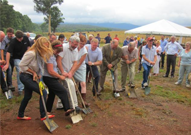
.
.
The Ferguson Tree – lest we forget
.
“The tallest tree ever properly measured was a Eucalyptus tree and was 436 feet tall. It was measured by William Ferguson on the 21st of February in 1872. Alarmingly the crown was broken off when the tree was still 1 meter thick, leading to claims that it once was up to five-hundred feet tall in one point in its lifetime.”
The length was a staggering (if true) 133 metres (436 feet) with its crown (the tree’s top) broken off!! The stump’s diameter five feet off the ground was 5.5m (18 feet) and at its broken top its diameter was still 1 metre. It is estimated that had this tree actually still been intact it would have approached 152m (500 feet) in height. The surveyor also noted numerous fallen trees in the same area over 106m (350feet) in height.
It would have been a Mountain Ash or Eucalyptus regnans. Sorry, no photo available. The legend remains only in text.
[Source: ^http://jtpredwoods12345.blogspot.com/]
.
.
‘VicForests accused of felling old-growth mountain ash’
.
[Source: Adam Morton, 20100629, The Age newspaper, ^http://www.theage.com.au/victoria/vicforests-accused-of-felling-oldgrowth-mountain-ash-20100628-zf5o.html]
.
‘The Victorian government’s forestry arm will face a legal challenge over claims it illegally logged old-growth forest and increased the risk to a threatened species.
Environmental groups accuse VicForests of felling dozens of pre-1900 ash eucalypts, breaching the Central Highlands Forest Management Plan. An impending legal case will also claim the timber agency failed to protect habitats necessary for the survival of Victoria’s threatened faunal emblem, Leadbeater’s possum.
Ecologist Jacques Cop, from consultants Acacia Environmental Group, said a survey of just one coupe near Toolangi found 31 pre-1900 ash eucalypts had been logged. Five stumps were more three metres across.
”These are trees that are 200 or 300 years old,” he said.
Mr Cop said the area should also have been protected as a Leadbeater’s possum habitat as it met the threshold of having at least 12 hollowed trees within three hectares. He said neither the state Department of Sustainability and Environment nor VicForests carried out ground surveys to check if ecological requirements were being met. Sarah Rees, president of local group My Environment, said the situation was an emergency.
’31 pre-1900 ash eucalypts had been logged’
.
“If this doesn’t stop we’re going to lose the last viable habitat for a range of different species, but Leadbeater’s possum carries the strongest case for legal protection“, she said.
The state government said it took the allegations “extremely seriously“.
Spokesman Michael Sinclair said VicForests would investigate the alleged breaches and report to the Department of Sustainability and Environment. VicForests spokesman David Walsh said the agency carried out detail planning before harvesting to ensure it acted within the law and had offered to meet local residents to better understand their concerns.
“No old-growth forest is harvested by VicForests in Victoria’s central highlands region”, he said.
The legal case, being prepared on behalf of a group called the Flora and Fauna Research Collective, comes amid community concern about the scale of logging in the central highlands after the Black Saturday bushfires.
The Wilderness Society said that evidence supporting the latest claims showed illegal logging of native forests was rife under the state government’s watch.
A separate allegation of illegal logging at Brown Mountain, in east Gippsland, is the subject of a pending Supreme Court judgment.
“Premier Brumby must act now to end VicForests’ woodchip rampage in Victoria’s magnificent native forests“, said Wilderness Society spokesman Luke Chamberlain.

Sarah Rees at the base of an ancient mountain ash spared the chainsaw but killed during a clean-up fire near Toolangi.
She says the present situation is an emergency.
Photo: John Woudstra
.
.
 VicForests motto reads: “Victorian Timber: beautiful, natural, functional” VicForests motto reads: “Victorian Timber: beautiful, natural, functional”
[SOURCE: http://www.vicforests.com.au/]
.
..in lay terms, this means kill beautiful natural specimens – they make the finest woodchips for reliable REFLEX office paper.
.
.
VICFORESTS: “VicForests employs over 140 staff across 10 Victorian sites located in Melbourne, Healesville and regional areas of Central Highlands and East Gippsland.
We have a variety of exciting career opportunities available – our Foresters specialise in tactical and operational planning, roading, harvesting and contract management, silviculture and native forest regeneration.
Other career paths include customer management, resource and business analysts, safety and risk, operational audit, forest scientists and product delivery.”
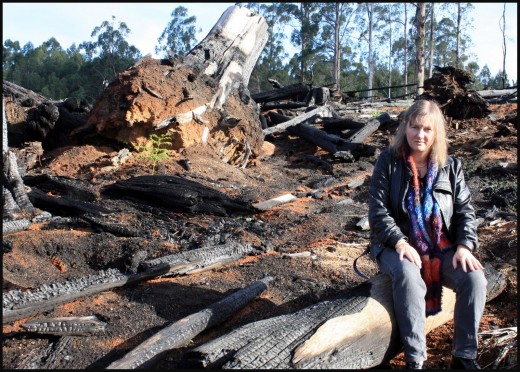
VICFORESTS: “We also employ staff in non-forestry roles including IT, HR, communications, finance, administration and customer service. A significant proportion of our staff and contractors are also involved with fire-fighting efforts each year.
VicForests is focused on investing in its employees through training, development, and providing career opportunities.”
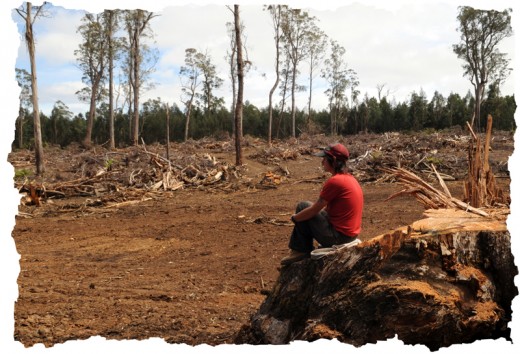
VICFORESTS: “We look for dynamic people who have a strong desire to be part of an organisation that strives to achieve success through implementing excellent and innovative business and timber industry practices for our customers and stakeholders.
Contributing to the timber industry is something that VicForests and its staff are proud of.”
.
[Source: ^http://vicforests.logic1.com.au/employment.htm, accessed 20110819]
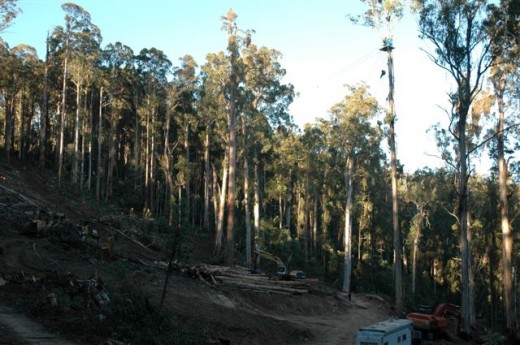 Vicforests’ coup at Stoney Creek
East Gippsland 2009 Vicforests’ coup at Stoney Creek
East Gippsland 2009
.
.
‘VicForests’ 2009 Annual Report reveals $5.1 million loss’
.
‘VicForests’ 2009 Annual Report has once again revealed that the logging agency continues to waste taxpayer millions of dollars sending our forests to the woodchip mills. The report shows that VicForests has posted a loss this year of $5.1 million. This is on top of last year posting a tiny profit after receiving a $5 million lifeline from government, and a loss the previous year.
 Woodchip train makes its way to Midways, Geelong (2009) for as little as $2.50 per tonne.
Photo: Wilderness Society Collection
Woodchip train makes its way to Midways, Geelong (2009) for as little as $2.50 per tonne.
Photo: Wilderness Society Collection
.
‘Whilst VicForests squanders Victorian taxpayer’s hard earned money, woodchipping and paper companies continue to post handsome profits. Whilst we don’t yet know how much they will make for 2009, South East Fibre Exports, a wholly owned subsidiary of Japanese paper giant, Nippon Paper, last year made over $10 million profit. They woodchipped approximately half a million tonnes of Victoria’s native forests, and this year paid as little as $2.50 per tonne for them.
Another giant company, Australian Paper, which makes Reflex papers, is VicForests’ largest single customer and was recently purchased for around $700 million by Nippon Paper. The $5.1 million loss is on top of an extra $1.3 million handout for bushfire recovery and does not include the massive $29 million royalty that it has failed to hand over to the state government who, along with the Victorian public, own these forests.’
.
[Source: ^http://www.wilderness.org.au/campaigns/forests/vicforests-2009-annual-report-reveals-5.1-million-loss]
 A tombstone of the once impenetrable forest.
A Mountain Ash stump alongside an old forestry track in Balnook, Gippsland.
Note the notches cut in the trunk for standing planks to cut the tree down by axe!
A tombstone of the once impenetrable forest.
A Mountain Ash stump alongside an old forestry track in Balnook, Gippsland.
Note the notches cut in the trunk for standing planks to cut the tree down by axe!
.
.
Reflex Office Paper
‘Paperlinx’s giant Maryvale mill located in Victoria’s Central Highlands is the largest pulp and paper making complex in Australia, consuming 475,000 cubic metres of eucalyptus forest per annum (RFA, 1998).
‘In July 2006, the Maryvale Mill received Forest Stewardship Council (FSC) Chain of Custody Certification for A4 Reflex products manufactured on its Number 3 and Number 5 Paper Machines. Paperlinx has been proudly promoting its environmental credentials ever since (as well as before).
Paperlinx is Australia’s only office paper producer. Its flagship product REFLEX copypaper is 100 per cent virgin native forest. Woodchips to make the paper are sourced from areas including rainforest, old growth forest, endangered species habitat and Melbourne’s largest water source, the Thompson Dam catchment area. Woodchips are also sourced from the Strzelecki Rainforest Reserve, an area that was promised protection by the state government due to its high conservation value.
These areas can be visited and viewed first hand, or determined by satelite image maps which show different forest types (such as rainforest as compared to woodlands) and where logging is occuring. The fact that Paperlinx gained FSC accreditation has raised concerns amoung environment groups who have been campaigning for the protection of these areas for over a decade.
Reflex Recycled Paper
Paperlinx has recently released a brand of paper wrapped in green packaging labelled Recycled. Fifty percent of REFLEX Recycled paper is made from pre-consumer waste (printers’ offcuts), but no genuine post-consumer (eg kerbside collected) recycled papers. The other fifty percent is from the same virgin native forest as stated above.
According to The Wilderness Society Paperlinx has the resources and technology to make use of alternative sources such as plantations and recycled paper, but doesn’t do so as it receives state-owned native forest logs for a significantly lower cost than plantation logs.
Due to the lack of accurate information reaching the public, an alliance of Australia’s peak environment groups including The Wilderness Society, Environment Victoria, Friends of the Earth and the Australian Conservation Foundation released a flier in 2004 urging people to boycott REFLEX paper and listing alternatives.
THE ALTERNATIVE
There is no 100 per cent recycled office paper manufactured in Australia. Brands made overseas that are available in Australia include Evolve, Canon 100 and Fuji Xerox Recycled Supreme.’
[Source: ‘Reflex Office Paper‘, Greenwash .org ^http://www.greenwashreport.org/node/41 ]
.
‘Always rely on Reflex to woodchip old growth‘
  Scott Gentle from the Victorian Forest Contractors Association
questions the logic of the Yarra Ranges council’s decision to boycott Reflex paper products.
[Source: ^http://free-press-leader.whereilive.com.au/news/story/paper-ban-anger/] Scott Gentle from the Victorian Forest Contractors Association
questions the logic of the Yarra Ranges council’s decision to boycott Reflex paper products.
[Source: ^http://free-press-leader.whereilive.com.au/news/story/paper-ban-anger/]
.
.
Further Reading:
.
[1] ‘Brown Mountain Rape’, ^http://candobetter.net/node/1005
[2] Ethical Paper, ^http://www.ethicalpaper.com.au/
[3] Save Sylvia Creek Toolangi, ^http://www.myenvironment.net.au/index.php/me/Community/SAVE-Sylvia-Creek-Toolangi
[4] Brown Mountain – final court orders, ^http://www.eastgippsland.net.au/?q=campaigns/brown_mountain/whats_new
[5] Reflex Office Paper, ^http://www.greenwashreport.org/node/41
[6] Victorian Supreme Court Decision: ‘Environment East Gippsland Inc v VicForests [2010] VSC 335 (11 August 2010)’, ^http://www.austlii.edu.au/au/cases/vic/VSC/2010/335.html
.
.
– end of article –
Tags: Acacia Environmental Group, Australian Paper, Brown Mountain, chainsaw-speak, East Gippsland logging, ecological genocide, Ferguson Tree, Forestry Standard 4708, Forestry Standard Certification, Gippsland Giants, illegal logging, Leadbeater’s possum, Logging, Nippon Paper Group, Reflex Paper, Toolangi, VicForests
Posted in Gippsland (AU), Possums and Gliders, Threats from Deforestation | No Comments »
Add this post to Del.icio.us - Digg
Saturday, March 26th, 2011
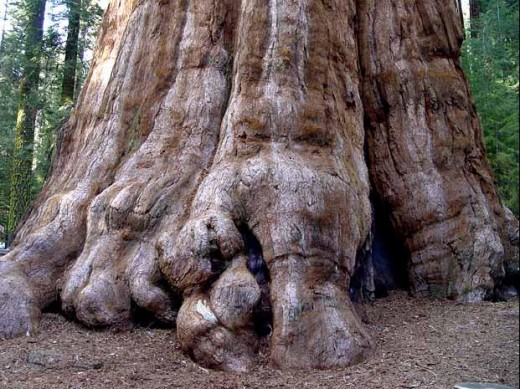 ‘General Sherman’ ~ just another sequoia? (pronounced ‘sequoya’)
Sequoia & Kings Canyon, Sierra Nevada, California, USA
^http://www.nps.gov/seki/historyculture/gfgst.htm ‘General Sherman’ ~ just another sequoia? (pronounced ‘sequoya’)
Sequoia & Kings Canyon, Sierra Nevada, California, USA
^http://www.nps.gov/seki/historyculture/gfgst.htm
.
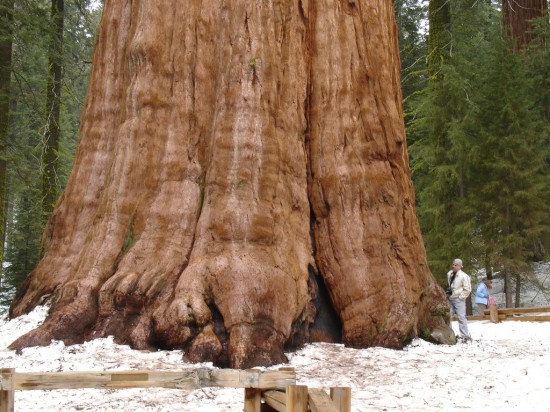 The General Sherman Tree
– the world’s largest tree, is the prime visitor attraction in the Giant Forest.
[Source: ^http://www.nps.gov/seki/historyculture/gfgst.htm]
. The General Sherman Tree
– the world’s largest tree, is the prime visitor attraction in the Giant Forest.
[Source: ^http://www.nps.gov/seki/historyculture/gfgst.htm]
.
“Sequoia sempervirens’ common names include coast redwood, California redwood, and giant redwood. It is an evergreen, long-lived, monoecious tree living 1200–1800 years or more. This species includes the (current) tallest trees on Earth, reaching up to 379 feet (115.52 m) in height and up to 26 feet (7.9 m) diameter at breast height. Before commercial logging and clearing began by the 1850s, this massive tree occurred naturally in an estimated 2.1 million acres along much of coastal California (excluding southern California where rainfall is not abundant enough) and the southwestern corner of coastal Oregon within the United States.” [Source: ^Wikipedia – read more].
.
“The Sierra Nevada is still growing today. The mountains gain height during earthquakes on the east side of the range. But the mountains are being shortened by erosion almost as quickly as they grow. This erosion has deposited sediments thousands of feet thick on the floor of the San Joaquin Valley.”
[Source: ^http://www.nps.gov/seki/historyculture/gfgst.htm]
.
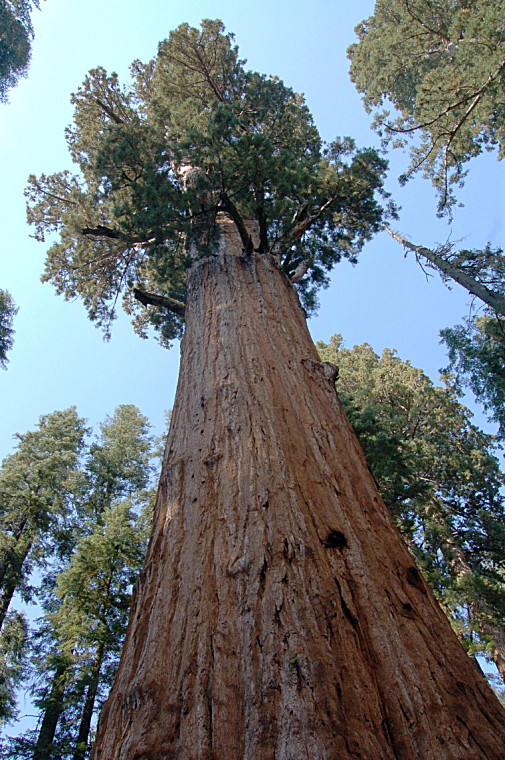
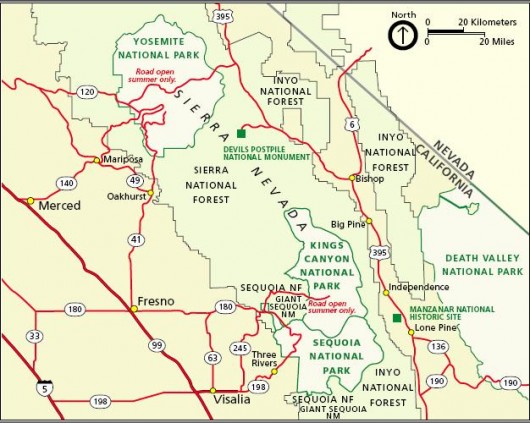
.
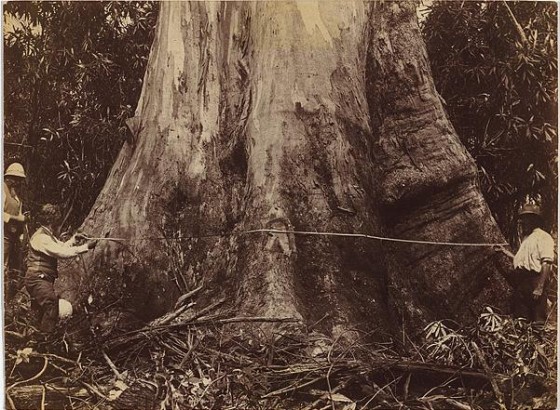 ‘Giant tree’ at Neerim (Gippsland, Victoria, Australia), forty feet girth c.1889
AUSTRALASIAN ART, Photo by Nicholas CAIRE, b.1837 Guernsey, United Kingdom – Australia d.1918[Gelatin silver photograph image 15.0 h x 20.2 w cm, Purchased 1983, Accession No: NGA 83.3083]
.
.
“The men shown here measuring the diameter of a giant eucalypt were not loggers or tree-lovers. They were attempting to determine whether Australian trees were bigger than the famed 400-foot giant redwoods of California. It was mostly national pride surrounding the Australian Centennial of European settlement which motivated scientists and photographers in the 1880s to seek out the remaining giant trees in the more remote areas of Victoria. The Americans claimed that their redwoods were the greatest because of their combined height and girth. In the dense Australian bush, it
was easier to measure the girth than the height and presented a much more dramatic image for a photograph.
.
The general public followed the giant tree debate in the papers and also purchased photographs of them and other idyllic bush scenes. By the late 19th century, the Australian population mostly lived and worked in the cities. They became day-trippers and used the new railway networks to take their recreation in the bush. Nicholas Caire, one of the most active photographers to seek out and record the giant trees, travelled over a number of years on the new rail line to Neerim town reserve.
.
Australia’s giant trees were widely depicted in colonial art as mighty symbols of the pre-settlement and pioneer era. Caire, whilst accepting the desirability of logging and urban development, was also one of those who argued for the preservation of examples for future generations.
.
Most of the awesome giant trees were felled or burnt in his lifetime. Now they are preserved only in photographs.” ‘Giant tree’ at Neerim (Gippsland, Victoria, Australia), forty feet girth c.1889
AUSTRALASIAN ART, Photo by Nicholas CAIRE, b.1837 Guernsey, United Kingdom – Australia d.1918[Gelatin silver photograph image 15.0 h x 20.2 w cm, Purchased 1983, Accession No: NGA 83.3083]
.
.
“The men shown here measuring the diameter of a giant eucalypt were not loggers or tree-lovers. They were attempting to determine whether Australian trees were bigger than the famed 400-foot giant redwoods of California. It was mostly national pride surrounding the Australian Centennial of European settlement which motivated scientists and photographers in the 1880s to seek out the remaining giant trees in the more remote areas of Victoria. The Americans claimed that their redwoods were the greatest because of their combined height and girth. In the dense Australian bush, it
was easier to measure the girth than the height and presented a much more dramatic image for a photograph.
.
The general public followed the giant tree debate in the papers and also purchased photographs of them and other idyllic bush scenes. By the late 19th century, the Australian population mostly lived and worked in the cities. They became day-trippers and used the new railway networks to take their recreation in the bush. Nicholas Caire, one of the most active photographers to seek out and record the giant trees, travelled over a number of years on the new rail line to Neerim town reserve.
.
Australia’s giant trees were widely depicted in colonial art as mighty symbols of the pre-settlement and pioneer era. Caire, whilst accepting the desirability of logging and urban development, was also one of those who argued for the preservation of examples for future generations.
.
Most of the awesome giant trees were felled or burnt in his lifetime. Now they are preserved only in photographs.”
~Anne O’Hehir
.
Indeed…
“The largest tree on Planet Earth is not the California Redwood, but the Mountain Ash (Eucalyptus regnans). The largest trees ever recorded were located in southern Australia near present day Melbourne. The world’s largest tree was the Ferguson Tree at over 500 feet (154m). It was measured by Surveyor Ferguson in 1872 in the Watts River Catchment near Healesville.”
Read More: Click: http://www.baddevelopers.green.net.au/Docs/talltrees.htm
.
Source: Text © National Gallery of Australia, Canberra 2010, Anne Gray (ed), Australian art in the National Gallery of Australia, National Gallery of Australia, Canberra, 2002, http://cs.nga.gov.au/Detail-LRG.cfm?IRN=106546&View=LRG
.
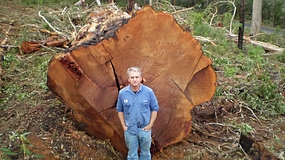
.
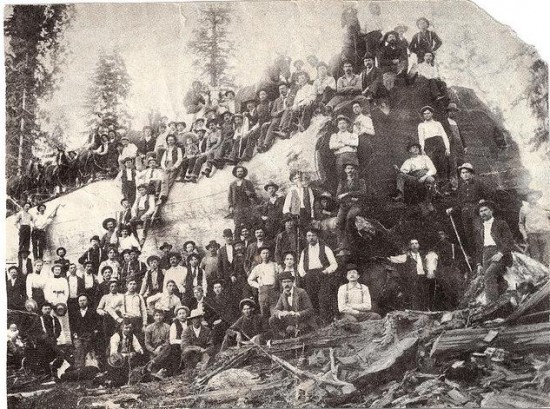 People and Horses on a Gigantic Redwood Log; about 1900.
“This photo is open for down loading for anyone wishing a free copy. Unknown Photo History. I’m fairly certain the tree was a Coast Redwood (Sequoia semperviren) or a Giant Sequoia (Sequoiadendron giganteum) from Central to Northern California or Oregon. I wish this one was still standing. The bark has already been stripped off of it.” [Source: Photo of old photo by David Foster, http://www.flickr.com/photos/21734563@N04/2225069096/] People and Horses on a Gigantic Redwood Log; about 1900.
“This photo is open for down loading for anyone wishing a free copy. Unknown Photo History. I’m fairly certain the tree was a Coast Redwood (Sequoia semperviren) or a Giant Sequoia (Sequoiadendron giganteum) from Central to Northern California or Oregon. I wish this one was still standing. The bark has already been stripped off of it.” [Source: Photo of old photo by David Foster, http://www.flickr.com/photos/21734563@N04/2225069096/]
.
.
Editor’s Comment:
I empathise with David Foster. – ‘I wish this one was still standing‘. Every face in this 1900 photo conveys cultural achievement and exploitative pride.
Now in 2011, has human attitude and on-ground impact toward ‘Old Growth’ really changed any?
Consider ‘Merbau’ timber, readily available from local timber yards across Australia and in New Zealand as ‘Kwila’ (Botanical names: Intsia bijuga and Intsia palembanica). Comparable old-growth rainforest hardwoods include Narra, Yakal, and Ipil. These old growth giants continually to be currently logged illegally deep in rain forests of the Philippines, Solomon Islands, Fiji and Papua New Guinea. Australian and New Zealand households profit from SE Asian rain forest destruction.
The lost natural assets of giant trees, of old growth have diminished the Earth, and have diminished the value of humanity, and of humanity’s value to the Earth. To forest habitat we are but marauders and rapists.
Humanity has become ‘Earth’s Pathogen’.
.
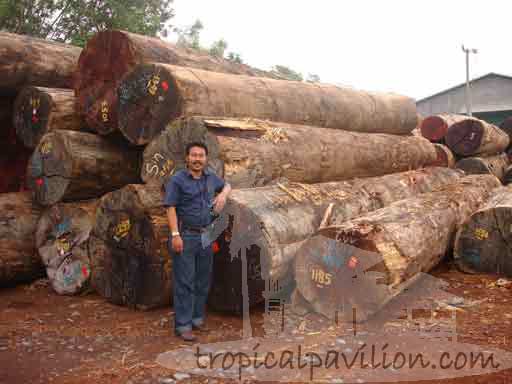 . .
 SE Asia old growth Rainforest Kwila is marketed in Australia and New Zealand as ‘Merbau’
for use mainly in flooring and decking,because of its relative hardness (high Janka rating) and long term stability. SE Asia old growth Rainforest Kwila is marketed in Australia and New Zealand as ‘Merbau’
for use mainly in flooring and decking,because of its relative hardness (high Janka rating) and long term stability.
.
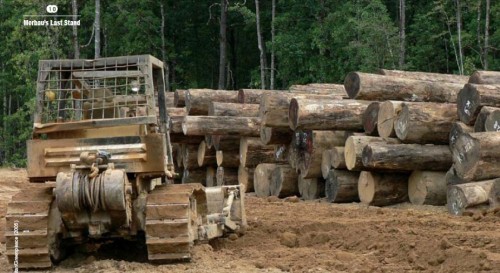
.
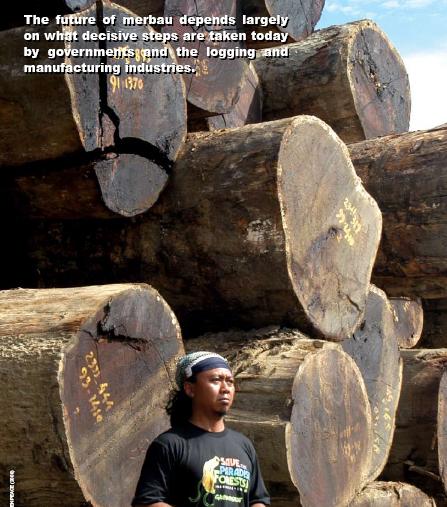
.
.
Rimbunan Hijau Group of Companies
.
“Malaysia’s largest timber group is Rimbunan Hijau (“Forever Green”) (Forbes, 1995). It has timber concessions in Sarawak of around 800,000 hectares (FT,1994), dominates Papua New Guinea’s forestry sector and has forestry interests in New Zealand and China, as well as diversifying into other activities such as the ownership of newspapers in Malaysia and Papua New Guinea (AsiaMoney, 1995). Rimbunan Hijau also owns a 40% share in Limgang Trading Sdn., which has a 310,000 hectares concession in Sarawak (55% of Limbang is owned by Sarawak’s Minister for the Environment and Tourism, James Wong Kim Min) It is privately owned and controlled by one family, headed by Tiong Hiew King. The family are estimated to be worth about US$2.5 billion (Forbes, 1995).”
“Whilst it remains largely a private group of companies, whose operations are veiled in secrecy, the Tiong family has sought to obtain a more public face through the reverse take-over of Berjaya Textiles Bhd (now renamed Jaya Tiasa Holdings Bhd), giving it a listing on the Kuala Lumpur Stock Exchange (FT 1994). Its overseas logging operations appear to remain under the control of the private parts of the group and in Papua New Guinea it is the dominant player through control of a number of associate and subsidiary companies. There are recent rumours that Rimbunan Hijau group owns, or is in the process of acquiring, Primegroup Holdings, a British Virgin Islands registered company with logging interests in Guyana and Papua New Guinea. If this is true, then Rimbunan Hijau group’s international logging interests are, or will shortly become, even more extensive, both geographically and in terms of size. Apart from its logging activities, the company has interests in banking, newspapers and oil-palm plantations. One of Hiew King’s younger brothers is a member of the Malaysian Parliament. Despite the company’s political connections, it has been caught for tax evasion, the Asian Wall Street Journal reported.”
.
[Source: Greenpeace, 1997, http://archive.greenpeace.org/comms/97/forest/asian_companies_malaysia.html, accessed 20110325].
.
“Rimbunan Hijau is a Malaysian based global forest logger and controls around 60% of the forest industry in Papua New Guinea. Rimbunan Hijau is Logging vast areas of virgin PNG forest against national opinion and local customs which infringes on the traditional rights of indigenous resource owners.
- (It is) accused in PNG Government reports of gross human rights abuses, labor abuses, sexual abuses and illegal logging.
- Causing destruction of ancient natural forest and associated systems.
- Conducting broad scale industrial logging operations that infringe on the rights of local people to establish and exploit alternative economic opportunies.
- Is influencing political and other processes to gain and maintain a near monopoly on PNGs forest resources and avoid adequate scrutiny and monitoring of its operations.
- Rimbunan Hijau uses the media to promote its operations to the PNG public – Rimbunan Hijau already OWNS The National newspaper and LEGAL THREATS against their only competitor, the Post Courier, have left it wary of criticising Rimbunan Hijau. These have been the only two print media outlets since The Independent was closed down.”
.
[Source: http://www.forestnetwork.net/rhw/]
.
Rimbunan Hijau is ultimately 50% owned by the Boral “Group” of Australia and 50% by Caltex.
[Source: http://www.scribd.com/doc/24211537/2258-Christchurch-New]
.
…so when Australians and New Zealanders buy Merbau timber from local timber yards, hardward stores and furniture retailers – they are driving South East Asian old growth rainforest deforestation.
.
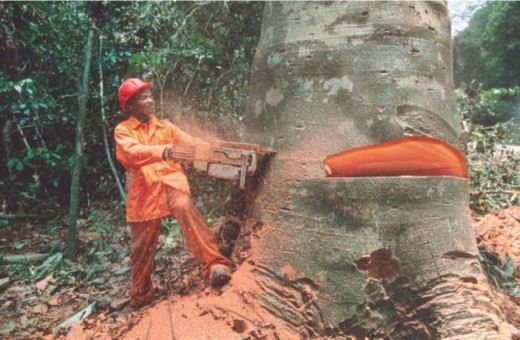
.
.
(The following article from The Guardian in February 2011 is by forests officer for WWF Indonesia, Jimmy Bond, based in West Kalimantan on the island of Borneo)
.
Complacency over deforestation pushes orang-utan closer to extinction
.
“Illegal logging and hunting continues despite legal protection, so the WWF is raising awareness to help save the orang-utan.
The destruction of the world’s rainforests continues at an alarming rate. Where I’m from in Borneo, illegal logging, coupled with hunting, is driving species such as the orang-utan ever closer towards extinction.
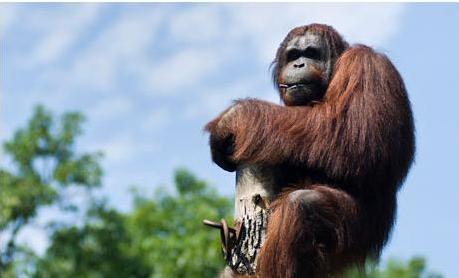 Borneo male orang-utan Wandoo.
There are fewer than 2,000 wild orangutans left in the West Kalimantan province, Indonesia.
©Photograph: Attila Balazs/epa/Corbis Borneo male orang-utan Wandoo.
There are fewer than 2,000 wild orangutans left in the West Kalimantan province, Indonesia.
©Photograph: Attila Balazs/epa/Corbis
.
There are three subspecies of orangutan in Borneo and we only have about 2,000 orangutans left in the wild in West Kalimantan province, and through deforestation and hunting their numbers continue to fall. Just last month I heard from villagers that some people are still killing and eating them even though they’re supposed to be protected by law.
I’ve just been travelling around the region in this part of Indonesia as I’ve been running a series of summer schools as part of a WWF awareness campaign to highlight the problems facing the orang-utan.
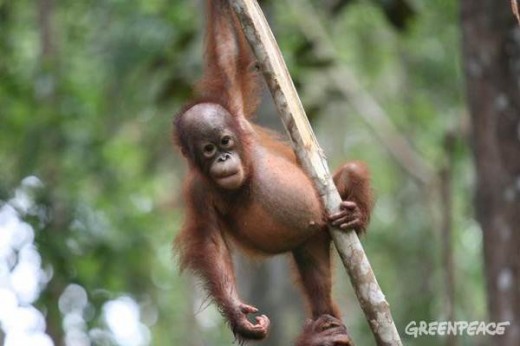
Over the past two years, the main focus for the campaign has been children because we’ve found it very difficult to change the minds and attitudes of older generations. We invite the kids to come along to these camps from nearby villages and at the last one more than 200 kids turned up. We do many different activities from drawing to tug-of-war competitions but the over-arching aim is to touch their hearts with stories about this wonderful creature and the rainforests in which they live. We want to leave them with the understanding that these unique creatures need protecting.
We’re also starting to join forces with local government officials and religious leaders to spread the message to communities that live in traditional longhouses. We tell them about a recent success story that acts as a warning against killing orang-utans. One trader in Pontianak, where I’m based, was recently jailed for two years for trading orang-utans.
Such discussion also helps us talk about their habitats and the need to protect them too. In West Kalimantan from 1995, large-scale illegal logging cut through a forest corridor that linked two national parks where one of three subspecies of orang-utan (Pongo pygmaeus pygmaeus) lives. This meant they couldn’t migrate between the two areas and their numbers dropped significantly. This was made worse because the illegal loggers who came here to work also hunted meat from the forests and the orang-utans were in the firing line.
Over the past few years we’ve been trying to highlight these problems to the international media because some of the illegally logged timber was transported over the border to Malaysia where it is made into wood products that are shipped all over the world. Globally, we want people to become educated about where the timber that makes their furniture comes from and the harm it is doing to species and communities. When the forest disappears people no longer have access to food and medicines plus we have also seen more flooding as a result of deforestation. The international media focus also helps push our government to react because not so long ago they were doing nothing to help.
Recently, we’ve seen companies get permits from the government to develop palm oil plantations. But what’s worse is that the permits are just a smokescreen for the companies to get at the timber and leave without planting any palm oil.
So we’re working to make indigenous communities aware of this practice and the best way to do this is by bringing in others who have seen this happen on their land to warn them. If they are forewarned then they know not to allow it to happen to their own communities. These people need to have the forest in good condition because it’s not only home to different species, it’s also where they earn their livelihood.
Looking to the future, my big ambition is to set up an orang-utan rehabilitation centre here in West Kalimantan for subspecies Pongo pygmaeus pygmaeus. At the moment, orphaned babies are taken to other parts of the country where they are kept with the two other subspecies. I want them to be able to breed with their own kind otherwise they could die out. And I fear that if the orangutan disappears, the rainforest won’t last much longer either.”
[Source: The Guardian newspaper (UK) , http://www.guardian.co.uk/environment/blog/2011/feb/03/indonesia-deforestation-orangutan-extinction, accessed Feb 2011]
.
.
Further Reading
.
http://www.nps.gov/seki/historyculture/gfgst.htm
http://en.wikipedia.org/wiki/Intsia_bijuga
http://www.indonesianrainforest.org/irf-news/373-campaign-against-kwila-imports-continues-.html
http://rainforest-action.blogspot.com/2010/09/end-sales-of-kwila-timber-products.html
http://www.greenpeace.org/new-zealand/en/press/illegal-kwila-timber-imports-f/
http://www.info-ri.com/indonesia/rainforest-action-end-sales-of-kwila-timber-products/
http://www.robcousens.com.au/files/D512143129.pdf
http://www.dansson.com/kwila.htm
http://www.greenpeace.org/international/Global/international/planet-2/report/2008/7/merbau-report-2.pdf
Greenpeace, 1997, http://archive.greenpeace.org/comms/97/forest/asian_companies_malaysia.html
http://www.coolearth.org/306/whats-new-32/news-155/illegal-logging-threatening-malaysian-wildlife-453.html
http://www.wwf.org.my/media_and_information/wwf_position_statements/?5741
http://www.ewp.asn.au/certification/certificationcoc.html
http://www.forestnetwork.net/rhw/
http://www.atif.asn.au/
http://www.scribd.com/doc/24211537/2258-Christchurch-New
http://www.baddevelopers.green.net.au/Docs/talltrees.htm
The Guardian newspaper (UK) , http://www.guardian.co.uk/environment/blog/2011/feb/03/indonesia-deforestation-orangutan-extinction
.
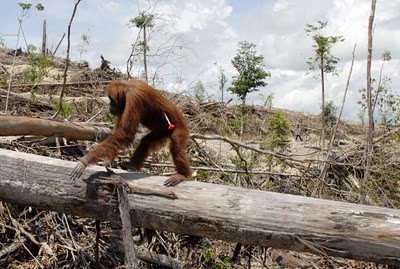 . .
Tags: Boral Group, Californian redwood, Caltex, commercial logging, deforestation, Earth's Pathogen, Eucalyptus regnans, Ferguson Tree, General Sherman Sequoia, Giant Forest, giant redwood, Guam, hallowed majesty, human pathogen, illegal logging, Intsia bijuga, Janka rating, Kalimantan, Kwila, Merbau, merbau flooring, Merbau's last stand, Narra, Neerim, old growth conservation, old growth forest, orang-utan, orang-utan extinction, Oregon, Primegroup Holdings, Rainforest Kwila, Rimbunan Hijau, San Joaquin Valley, Sarawak, Sequoia sempervirens, Sequoiadendron giganteum, Sierra Nevada, significant trees, world's largets tree, Yakal
Posted in 31 Old Growth Conservation!, Congo (CD), Kalimantan (ID), Sumatra (ID), Threats from Deforestation | No Comments »
Add this post to Del.icio.us - Digg
Thursday, August 26th, 2010
by Editor 20100826.
East Gippsland, Victoria April 2009:
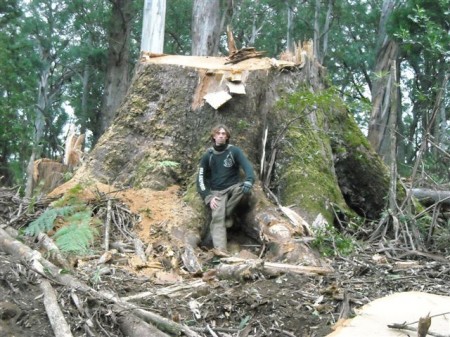 The senseless killing of a 500+ year old rare surviving Eucalyptus regnans
by VicForest contractors in April 2009.
( Photo courtesy of Environment East Gippsland) The senseless killing of a 500+ year old rare surviving Eucalyptus regnans
by VicForest contractors in April 2009.
( Photo courtesy of Environment East Gippsland)
Logging halted at iconic Bungywarr Creek (East Gippsland, Victoria, Australia)
29 April, 2009
‘Today independent forests conservationists are protecting ancient forests from logging in far East Gippsland.
“Two protestors are ‘flying’ a platform located thirty metres up in the tree canopy”, says spokesperson for the group, Ms Lauren Caulfield. “This platform is cabled off to four logging machines, immobilizing them.”
The tree-top protestors are supported by twenty-five forests conservationists on the site.
Bungywarr Creek was first blockaded in 1994, and has remained a contentious logging site ever since.
“Bungywarr Creek forest was identified as iconic almost two decades ago. The old-growth that remains at Bungywarr should be included in the Brumby government’s next round of forest protection”, said Ms Caulfield.
Earlier this month it was revealed that forests like the magnificent stands along Bungywarr Creek are sold to export woodchipping companies for less than the price of a Mars bar – a mere $2.50 per tonne.
“Selling our valuable and carbon-rich native forests for the price of a fast food snack is not making the best financial returns to Victorians”, said Ms Caulfield.
“For VicForests to continue to woodchip the remaining 8% of Victoria’s old-growth forests under Mr Brumby’s watch is a disgrace. Victorians expect and deserve management of our forests for a truly sustainable future.”
“Protecting nature is one of the most important ways to fight climate change”, continued Ms Caulfield. “The forest at Bungywarr Creek will do a better job fighting climate change if it is left intact and able to suck carbon dioxide out of the atmosphere.”
“While the Brumby government dithers on delivering the ageing 2006 old-growth forest promise, logging at Bungywarr Creek is making climate change worse”, concluded Ms Caulfield.”
[Media Release courtesy of Environment East Gippsland]
© The Habitat Advocate Public Domain
|
|
 Forests in Laos have declined steadily in recent decades,
falling from 64% cover in 1960 to 41% in 2005.
Primary forests now cover less than 10 % of the country according to U.N. data.
(Source: Mongabay, ^http://news.mongabay.com/2011/0622-laos_crackdown.html)
Forests in Laos have declined steadily in recent decades,
falling from 64% cover in 1960 to 41% in 2005.
Primary forests now cover less than 10 % of the country according to U.N. data.
(Source: Mongabay, ^http://news.mongabay.com/2011/0622-laos_crackdown.html)
 Greater Mekong Region
Greater Mekong Region
 The forests of Laos support the livelihoods of millions of rural and indigenous people but are seriously threatened by over-exploitation; such is the volume of illegal timber flowing through Laos’ porous borders that its furniture manufacturing industry is finding it cannot supply orders due to a lack of raw materials.
The forests of Laos support the livelihoods of millions of rural and indigenous people but are seriously threatened by over-exploitation; such is the volume of illegal timber flowing through Laos’ porous borders that its furniture manufacturing industry is finding it cannot supply orders due to a lack of raw materials. Yellow balau log from Lao Peoples Democratic Republic, awaiting transportation.
Yellow balau log from Lao Peoples Democratic Republic, awaiting transportation.
 Source: ^http://www.seranotimber.com.au/yellow-balau.html
Source: ^http://www.seranotimber.com.au/yellow-balau.html



 Unprotected ancient native forests around Tasmania’s Recherche Bay
Unprotected ancient native forests around Tasmania’s Recherche Bay













 Woodchip train makes its way to Midways, Geelong (2009) for as little as $2.50 per tonne.
Photo: Wilderness Society Collection
Woodchip train makes its way to Midways, Geelong (2009) for as little as $2.50 per tonne.
Photo: Wilderness Society Collection



























